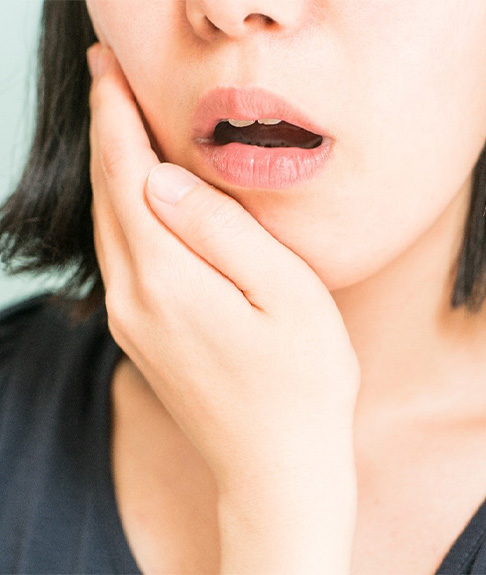TMJ Therapy – Lakewood, CO
Treating the Source of Headaches
and Jaw Pain
Maybe you have chronic headaches that don’t go away no matter what kind of treatment your regular physician tries. Or perhaps you’ve been dealing with jaw or neck pain that has only gotten worse as time passes. These are potential signs of TMD, and if you don’t act quickly, severe discomfort and limited jaw movement could be in your future. If you suspect you have TMD, call Dr. Carole Emanuel right away to discuss what your next steps should be; we can put you on the path toward lasting relief with TMJ therapy in Lakewood, CO.
What Is TMJ/TMD?

You may hear TMJ and TMD used interchangeably, but they’re two separate things. “TMJ” stands for “temporomandibular joint” whereas “TMD” is the abbreviation for “TMJ disorder.” The TMJ is the ball-and-socket joint that connects the lower jaw with the skull while TMD refers to any problem with said joint that causes pain, tenderness, or limited movement. There are a variety of risk factors for TMD, including jaw injury, different types of arthritis, long-term teeth grinding, and connective tissue diseases.
Symptoms of TMJ Disorder

Since TMD can stem from a variety of causes, your symptoms might not be the same as those of another patient. That said, there are several common warning signs you can watch out for. Below are a few examples of possible TMD symptoms. Any one of them on their own could possibly point to a problem with your jaw, so if they sound familiar, give our office a call right away to schedule an appointment.
Oral-Facial & TMD Pain
TMD is a frequent source of chronic facial pain. The most common form is myofascial pain, which occurs in the connective tissue covering the muscles and can be felt in your jaw, neck, and shoulders. You might also experience pain as a result of a dislocated disk in the TMJ or as a result of degenerative joint disease (such as osteoarthritis). Correctly identifying the cause of your pain is crucial for choosing an effective treatment method.
Difficulty or Pain While Chewing
When your jaw joint is out of alignment, you might notice that you’re having trouble chewing your food. It’s not uncommon for your teeth to fail to close properly when you bite down, and as a result, crunchy or chewy foods become much harder to handle. Sometimes your jaw muscles can compensate for the misalignment, but this often isn’t the case for more severe cases of TMD.
If you’ve had chewing problems lately, examine your teeth in the mirror to see how the top and bottom arches meet. Ideally, they should be able to touch each other evenly without straining or stretching. If this isn’t the case, there’s a good chance that you’ve developed a TMD.
Locking of the Joint
Severe TMD can occasionally cause the jaw joint to painfully lock. If this happens, you won’t be able to open or close your jaw at all. Sometimes you can unlock your jaw on your own by applying heating pads to the joint area to relax the muscles around it. That said, even if a locked jaw is temporary, it could happen again. As such, you should seek professional care as soon as possible if you notice this particular TMD symptom.
Tinnitus
Tinnitus is the scientific term for when there’s a ringing noise in your ears that isn’t caused by an external sound. Oftentimes, tinnitus occurs as a result of a TMD. Many researchers believe that it’s because the muscles responsible for chewing are next to the muscles that insert into the inner ear; another possibility is that there’s a connection between the ligaments in the jaw and one of the bones responsible for hearing.
Regardless of the exact cause, frequent tinnitus can be considered a possible warning sign of a TMD, especially if it’s accompanied by other symptoms such as jaw pain.
Types of TMJ Treatment

Our team will work to diagnose your TMD as quickly as possible, and we’ll try to narrow down what caused the problem in the first place. Then, based on your circumstances, we’ll put together a treatment plan to reduce your pain and give your jaw joint a chance to recover. We have various types of TMJ therapy available, and we’ll make sure that you’re aware of the different benefits before you have to make any commitments.
Equilibration / Occlusal Adjustments
The upper and lower teeth are meant to bite together a certain way. If the alignment is off, then the forces of your bite aren’t distributed properly, which can strain the TMJ and wear down your teeth. Equilibration (also known as occlusal adjustments) involves removing small amounts of enamel from your teeth so that they come together properly. This takes the pressure off your TMJ so that it can heal.
Occlusal Splints
An occlusal splint is a special kind of mouth guard used to treat TMJ pain and reduce the effects of grinding your teeth. The appliance is custom-made based on detailed models of your mouth and jaw. It provides support for the TMJ and the muscles used for chewing so that they have a chance to relax. It also keeps the upper and lower teeth separated so that your mouth is protected from the worst effects of the teeth grinding that’s associated with TMD.
Botox Therapy for TMJ
While you might be familiar with Botox as a way to reduce fine lines and wrinkles on your face, it has actually been used as a form of pain relief for decades. When injected into overactive or irritated TMJ muscles, it can stop the unconscious movements that cause teeth grinding, tension, and strain. This can provide almost immediate relief for the patient that should last for at least a few months, during which time our team can address the underlying cause of the issue to prevent unpleasant symptoms from coming back.

